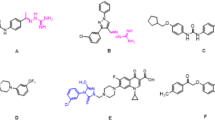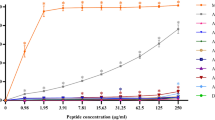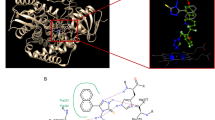Abstract
Four new peptaibiotics, acremotins A–D (1–4) featuring three α,α-dialkylated amino acid–imino acid motifs and an unreduced C-terminal residue, along with the known peptaibiotic XR586 (5) were isolated from the solid cultures of the soil-derived fungus Acremonium persicinum SC0105. Their primary structures were characterized by detailed analysis of the HRESIMS/MS fragmentation pattern combined with comprehensive interpretation of the 1D and 2D NMR spectroscopic data. The absolute configurations of amino acid residues were determined by the advanced Marfey’s method. Sequence alignment result shows that 1–4 are closely related to zervamicin IIB and emerimicin IIA, thus belong to peptaibiotic subfamily-3 (SF3). The three-dimensional (3D) structure of 4 was established by theoretical conformational analysis using the ab initio density functional theory (DFT) method, which, together with the CD spectrum, indicated an amphiphilic and helical structure for 4. 1–5 actively inhibited the growth of gram-positive bacterial pathogens, and amongst them 4 was the most potent compound showing MIC of 12.5 and 6.25 µg/ml against S. aureu and MRSA strains, respectively. 1–5 were also cytotoxic against three human cancer cell lines with IC50 ranging from 1.2 to 21.6 μM.
Similar content being viewed by others
Log in or create a free account to read this content
Gain free access to this article, as well as selected content from this journal and more on nature.com
or
References
Fox RO, Richards FM. A voltage-gated ion channel model inferred from the crystal structure of alamethicin at 1.5-Å resolution. Nature. 1982;300:325–30.
Karle L, Flippen-Anderson JL, Agarwalla S, Balaram P. Crystal structure of [Leu1] zervamicin, a membrane ion-channel peptide: Implications for gating mechanisms. Proc Natl Acad Sci USA. 1991;88:5307–11.
Sansom M, Balaram P, Karle I. Ion channel formation by zervamicin-IIB. Eur Biophys J. 1993;21:369–83.
Duclohier H. Peptaibiotics and peptaibols: an alternative to classical antibiotics? Chem Biodivers. 2007;4:1023–6.
Yun B-S, et al. Peptaivirins A and B, two new antiviral peptaibols against TMV infection. Tetrahedron Lett. 2000;41:1429–31.
Luo Y, et al. Antimicrobial peptaibols induce defense responses and systemic resistance in tobacco against tobacco mosaic virus. FEMS Micro Lett. 2010;313:120–6.
Otto A, et al. Chilenopeptins A and B, peptaibols from the Chilean Sepedonium aff. chalcipori KSH 883. J Nat Prod. 2016;79:929–38.
Ishiyama D, Satou T, Senda H, Fujimaki T, Honda R, Kanazawa S. Heptaibin, a novel antifungal peptaibol antibiotic from Emericellopsis sp. BAUA8289. J Antibiot. 2000;53:728–32.
He H, et al. Culicinin D, an antitumor peptaibol produced by the fungus Culicinomyces clavisporus, Strain LL-12I252. J Nat Prod. 2006;69:736–41.
Boot CM, et al. Four classes of structurally unusual peptides from two marine-derived fungi: Structures and bioactivities. Tetrahedron. 2007;63:9903–14.
Prasad BV, Sasisekharan V. A case study of the conformation of poly (α-aminoisobutyric acid): α-or 310-helix. Macromolecules. 1979;12:1107–10.
Paterson Y, Rumsey SM, Benedetti E, Nemethy G, Scheraga HA. Sensitivity of polypeptide conformation to geometry. Theoretical conformational analysis of oligomers of α-aminoisobutyric acid. J Am Chem Soc. 1981;103:2947–55.
Smith GD, et al. Crystal structures and conformational calculations of fragments of alamethicin containing aminoisobutyric acid. J Am Chem Soc. 1981;103:1493–501.
Marshall GR, et al. Factors governing helical preference of peptides containing multiple α,α-dialkyl amino acids. Proc Natl Acad Sci USA. 1990;87:487–91.
Degenkolb T, Berg A, Gams W, Schlegel B, Gräfe U. The occurrence of peptaibols and structurally related peptaibiotics in fungi and their mass spectrometric identification via diagnostic fragment ions. J Pept Sci. 2003;9:666–78.
Meyer C, Reusser F. A polypeptide antibacterial agent isolated from Trichoderma viride. Cell Mol Life Sci. 1967;23:85–86.
Daniel JF, Filho ER. Peptaibols of Trichoderma. Nat Prod Rep. 2007;24:1128–41.
McKernan PA, et al. Native calcitonin mimetics. US5698521 (1997).
Schiell M, et al. Cephaibols, new peptaibol antibiotics with anthelmintic properties from Acremonium tubakii DSM 12774. J Antibiot. 2001;54:220–33.
Degenkolb T, Heinze S, Schlegel B, Strobel G, Grafe U. Formation of new lipoaminopeptides, acremostatins A, B, and C, by co-cultivation of Acremonium sp. Tbp-5 and Mycogone rosea DSM 12973. Biosci Biotechnol Biochem. 2002;66:883–6.
Boot CM, Tenney K, Valeriote FA, Crews P. Highly N-methylated linear peptides produced by an atypical sponge-derived Acremonium sp. J Nat Prod. 2006;69:83–92.
Bruckner H, Becker D, Gams W, Degenkolb T. Aib and Iva in the biosphere: neither rare nor necessarily extraterrestrial. Chem Biodivers. 2009;6:38–56.
Andersson MA, et al. Acrebol, a novel toxic peptaibol produced by an Acremonium exuviarum indoor isolate. J Appl Microbiol. 2009;106:909–23.
Iijima M, et al. Acremopeptin, a new peptaibol from Acremonium sp. PF1450. J Antibiot. 2017;70:791–4.
Wu P, et al. Bisacremines E–G, three polycyclic dimeric acremines produced by Acremonium persicinum SC0105. Org Lett. 2015;17:4922–5.
Wu P, Yao L, Xu L, Xue J, Wei X. Bisacremines A–D, dimeric acremines produced by a soil-derived Acremonium persicinum Strain. J Nat Prod. 2015;78:2161–6.
Teesch LM, Orlando RC, Adams J. Location of the alkali-metal ion in gas-phase peptide complexes. J Am Chem Soc. 1991;113:3668–75.
Lin T, Payne AH, Glish GL. Dissociation pathways of alkali-cationized peptides: opportunities for C-terminal peptide sequencing. J Am Soc Mass Spectrom. 2001;12:497–504.
Sabareesh V, Balaram P. Tandem electrospray mass spectrometric studies of proton and sodium ion adducts of neutral peptides with modified N- and C-termini: synthetic model peptides and microheterogeneous peptaibol antibiotics. Rapid Commun Mass Spectrom. 2006;20:618–28.
Sharman GJ, et al. Structural elucidation of XR586, a peptaibol-like antibiotic from Acremonium persicinum. Biochem J. 1996;320:723–8.
Chikanishi T, Hasumi K, Harada T, Kawasaki N, Endo A. Clonostachin, a novel peptaibol that inhibits platelet aggregation. J Antibiot. 1997;50:105–10.
Singh SB, et al. Integramides A and B, two novel non-ribosomal linear peptides containing nine Cα-methyl amino acids produced by fungal fermentations that are inhibitors of HIV-1 integrase. Org Lett. 2002;4:1431–4.
Figueroa M, et al. Peptaibols, tetramic acid derivatives, isocoumarins, and sesquiterpenes from a Bionectria sp. (MSX 47401). J Nat Prod. 2013;76:1007–15.
Chugh JK, Wallace BA. Peptaibols: models for ion channels. Biochem Soc Trans. 2001;29:565–70.
Balashova T, et al. NMR structure of the channel-former zervamicin IIB in isotropic solvents. FEBS Lett. 2000;466:333–6.
Manning MC, Woody RW. Theoretical CD studies of polypeptide helices: Examination of important electronic and geometric factors. Biopolymers. 1991;31:569–86.
Toniolo C, Polese A, Formaggio F, Crisma M, Kamphuis J. Circular dichroism spectrum of a peptide 310-helix. J Am Chem Soc. 1996;118:2744–5.
Harada K, et al. A method using LC/MS for determination of absolute configuration of constituent amino acids in peptide-advanced Marfey’s method. Tetrahedron Lett. 1995;36:1515–8.
Fujii K, Ikai Y, Oka H, Suzuki M, Harada K. A nonempirical method using LC/MS for determination of the absolute configuration of constituent amino acids in a peptide: Combination of Marfey’s method with mass spectrometry and its practical application. Anal Chem. 1997;69:5146–51.
Fujii K, et al. A nonempirical method using LC/MS for determination of the absolute configuration of constituent amino acids in a peptide: Elucidation of limitations of Marfey’s method and of its separation mechanism. Anal Chem. 1997;69:3346–52.
Fu Y, Wu P, Xue J, Wei X. Cytotoxic and antibacterial quinone sesquiterpenes from a Myrothecium fungus. J Nat Prod. 2014;77:1791–9.
Wang C, Wu P, Shi J-F, Jiang Z-H, Wei X-Y. Synthesis and cancer cell growth inhibitory activity of icaritin derivatives. Eur J Med Chem. 2015;100:139–50.
Acknowledgements
The authors thank Ms. Aijun Sun, South China Sea Institute of Oceanology, Chinese Academy of Sciences, for HRESIMS/MS measurements. This work was supported by an NSFC grant (no. 81172942), a research project from the Bureau of Science and Technology of Guangzhou Municipality (Grant No. 201510010015), and a project from State Key Laboratory of Applied Microbiology Southern China (Grant No. SKLAM006-2015).
Author information
Authors and Affiliations
Corresponding author
Ethics declarations
Conflict of interest
The authors declare that they have no conflict of interest.
Electronic supplementary material
Rights and permissions
About this article
Cite this article
Wang, C., Wu, P., Yao, L. et al. Acremotins A–D, peptaibiotics produced by the soil-derived fungus Acremonium persicinum SC0105. J Antibiot 71, 927–938 (2018). https://doi.org/10.1038/s41429-018-0086-3
Received:
Revised:
Accepted:
Published:
Issue date:
DOI: https://doi.org/10.1038/s41429-018-0086-3
This article is cited by
-
Halovirs I–K, antibacterial and cytotoxic lipopeptaibols from the plant pathogenic fungus Paramyrothecium roridum NRRL 2183
The Journal of Antibiotics (2022)
-
Streptovertimycins A–H, new fasamycin-type antibiotics produced by a soil-derived Streptomyces morookaense strain
The Journal of Antibiotics (2020)



